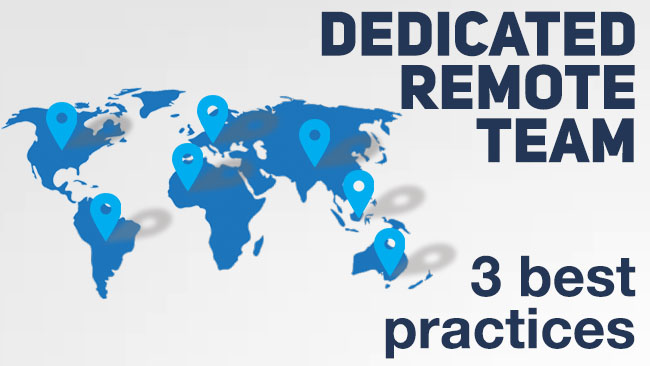
What is the most important resource of a business? We can address this question to different people managing different parts of businesses; however, the insights that we’ll gain will be confusing: the crown of “The Most Important Resource” would be contested by capital, hardware, and other factors. As far as our experience goes, we think that human resources can contribute the most, but they also need the most amount of management: a group of people in the same company isn’t a real team yet; they need to feel that they share the same goals and drives.
Now imagine you’re leading a remote team whose members don’t have the luxury of getting to know each other as well as their office counterparts — you’re running the risk of alienating your workers and creating a work environment in which people don’t really feel connected. Seeing your colleagues in person may seem insignificant; in reality, however, this is an important building block of a team that is oriented towards the same goal. Remote teams are no different — so we’ll guide you through a number of practices you can use to build a real team.
Practice 1: Build a company culture

From an outsider’s perspective, a company’s image is really simple and low-resolution: it has a name, a logo and a product. However, the people who work there perceive it differently: they’ve grown used to its visuals elements, its branding, even prestige associated with it. They value a set of work conditions that allow them to truly enjoy the work they’re doing — and this is where company culture steps in. Although this term can be interpreted as “having free snacks and coffee machine”, we argue that this notion is far more complex. Here are the insights from our experience:
Imagine the best software developer in the region. Besides actually working, their day also includes constant back-and-forth communication with recruiters, all of them trying to get this developer to work in their companies. Better salary, better projects, even a better coffee machine is offered — so inevitably, the developer (or any other high-tier professional) asks themselves: why not leave my current Company A to accept the offer of Company B?
Good company culture can actually help you retain your workers. Although it varies from company to company, its main idea is to help the workers appreciate their relationships with the company. Avoiding the rather cynical “Worker’s time in exchange for company’s money” approach, we can instead provide workers with a work environment that fosters being good at your remote job — and helping others reach the same level of competence. Learning opportunities, for instance, can become a sound foundation for great company culture.
In today’s fast-paced world, the learning process never stops: professionals understand this paradigm well and always strive to optimize what they know and stay informed about what they don’t know. A company that provides learning opportunities (which can be both industry-specific and general) is seen as a benefactor and professionals appreciate that.
Practice 2: Shared workflow

For a team whose members don’t interact in an office environment, it can be easy to lose track of what each member is doing: there’s no interconnection between different kinds of work being done in a project. This is akin to playing football blindfolded: you can only suspect that your teammates are actually doing something. Dividing workers into job-specific teams increases work efficiency, but prevents them from seeing beyond their workflow. In essence, the goal is to enrich their knowledge about the company as a whole: what do other teams do? How is their workflow organized? In which ways are your tasks connected?
This is where shared workflow comes in handy: shared Google Sheets can be used to document what each team member is doing: this allows every worker to see the broader picture of the company and appreciate other types of work which aren’t self-evident: when a system works flawlessly, we often take it for granted without thinking that keeping something error-free is hard work in and of itself. Managers can monitor their teams’ progress and provide feedback in an instant via shared drives (like Google Drive) — and allocate work tasks that need to be done faster.
Shared calendars can help members stay up-to-date about work progress as well, but another important feature is the opportunity to get to know each other better. For some people, sharing their personal information in informal “trivia sessions” with colleagues may be too intrusive, so they can decide to share it (if any) in calendars instead, marking birthdays, anniversaries, vacations and so on. These details, seemingly insignificant, help members connect on a more personal level — and this is practically a recipe for a real sports team!
Practice 3: Team building activities

Stress is arguably an inherent quality of any work: in startups and corporations, local business and international companies accidents like missing deadlines or unresolved work problems are not uncommon — and this can lead to worse job performance or more toxic work environment. In this case, we need to bring out the big gun — team building activities! They can help your professionals feel even more personally connected thanks to a lively, less formal atmosphere these events can create. Thanks to services like Google Hangouts and Skype, team building can now be done in a virtual environment.
Now, the question is: which activities exactly? To keep all members of the team interested, we need to find an activity that fits them all: a good criterion can be the type of work they do. Let’s say we have a sales team: their key skill is communication, so we need to set up an environment where they can hone their skillset in, while competing and having fun — this can be done in a debate club, for instance, taking place every month and helping members grow professionally and facilitate connection between them. The same result can be achieved via virtual meetups, groups or webinars — as long as there’s a common point of interest.
For a more laid-back experience, virtual board games (from relatively benign Monopoly to infamous Cards Against Humanity) sessions can be a great source of fun. Don’t be tricked by their simplicity, though: there is a region in our brain dedicated exclusively to playing games. They can highlight with great precision just how competitive or smart a person really is — knowledge that you can later utilize to improve your company.
Interestingly enough, some workers may happen to live in the same city which makes organizing get-togethers much easier, allowing for visits to a local bar or group hiking trips.
There are several factors attributing to remote job satisfaction among professionals. Some can be easily measured and used for leverage — salary, for example. Others are more abstract, like status. One of the most powerful factors is the feeling that you belong to a group which shares your interests and goals — and no matter the distance, this feeling can help you create the best team in the world!
(In fact, distance should never be a problem, especially when spreading knowledge — this is what we believe in when we create our articles. Still, with every post you share, our world gets more connected and distance less of a problem, so thanks for that!)






Really helpful article!